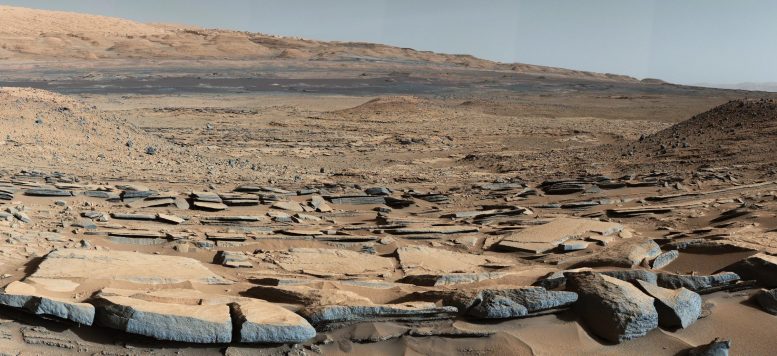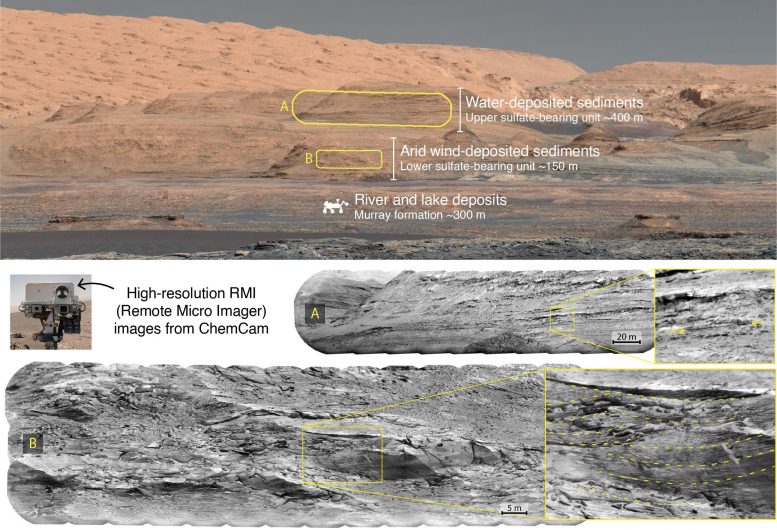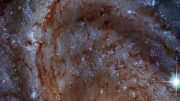
A view from the “Kimberley” formation on Mars taken by NASA’s Curiosity rover. The strata in the foreground dip towards the base of Mount Sharp, indicating flow of water toward a basin that existed before the larger bulk of the mountain formed. Credit: NASA/JPL-Caltech/MSSS
The Perseverance rover has just landed on Mars. Meanwhile, its precursor Curiosity continues to explore the base of Mount Sharp (officially Aeolis Mons), a mountain several kilometers high at the center of the Gale crater.
Using the telescope on the ChemCam instrument to make detailed observations of the steep terrain of Mount Sharp at a distance, a French-US team headed by William Rapin, CNRS researcher at the Institut de Recherche en Astrophysique et Planétologie (CNRS/Université Toulouse III/CNES)[1], has discovered that the Martian climate recorded there alternated between dry and wetter periods, before drying up completely about 3 billion years ago.

View of hillocks on the slopes of Mount Sharp, showing the various types of terrain that will soon be explored by the Curiosity rover, and the ancient environments in which they formed, according to the sedimentary structures observed in ChemCam’s telescope images (mosaics A and B). Credit: © NASA/JPL-Caltech/MSSS/CNES/CNRS/LANL/IRAP/IAS/LPGN
Spacecraft in orbit around Mars had already provided clues about the mineral composition of the slopes of Mount Sharp. But now, ChemCam has successfully made detailed observations of the sedimentary beds from the planet’s surface, revealing the conditions under which they formed. Moving up through the terrain observed, which is several hundred meters thick, the types of bed change radically.
Lying above the lake-deposited clays that form the base of Mount Sharp, wide, tall, cross-bedded structures are a sign of the migration of wind-formed dunes during a long, dry climate episode. Higher up still, thin alternating brittle and resistant beds are typical of river floodplain deposits, marking the return of wetter conditions. The climate of Mars therefore likely underwent several large-scale fluctuations between dry conditions and river and lake environments, until the generally arid conditions observed today took hold.
During its extended mission, Curiosity is scheduled to climb the foothills of Mount Sharp and drill into its various beds. It will test this model, characterize in more details how the ancient climate evolved, and possibly understand the origin of these major fluctuations.
Reference: “Alternating wet and dry depositional environments recorded in the stratigraphy of Mount Sharp at Gale crater, Mars” by W. Rapin, G. Dromart, D. Rubin, L. Le Deit, N. Mangold, L.A. Edgar, O. Gasnault, K. Herkenhoff, S. Le Mouélic, R.B. Anderson, S. Maurice, V. Fox, B.L. Ehlmann, J.L. Dickson and R.C. Wiens, 8 April 2021, Geology.
DOI: 10.1130/G48519.1
This work was supported by CNES, the French Space Agency, for overseeing the construction of the ChemCam instrument and operating it together with Los Alamos National Laboratory (New Mexico, USA).
Note:
[1] The other team members work at the Laboratoire de géologie de Lyon : Terre, Planètes, Environnement (CNRS/ENS de Lyon/Université Lyon 1) and the Laboratoire de Planétologie et Géodynamique (CNRS/Université de Nantes/Université d’Angers) in France; at UC Santa Cruz, US Geological Survey, California Insitute of Technoloy and Los Alamos National Laboratory in the USA.









Be the first to comment on "Mars Didn’t Dry Up in One Go – Martian Climate Cycled Between Dry and Wet Periods"